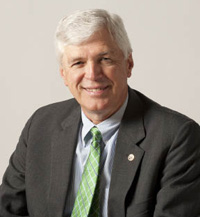B Surendar speaks to Thomas Watson, PE, Fellow ASHRAE, Life Member and 2012-13 ASHRAE President
ASHRAE’S first global District Cooling and Heating Design Manual, exclusively funded and sponsored by UAE-based Empower, has received the stamp of approval by experts. B Surendar speaks to Thomas Watson, PE, Fellow ASHRAE, Life Member and 2012-13 ASHRAE President, to get an insider’s view on the document and its implications to the sector.
 Thomas Watson, PE, Fellow Life Member, is Chief Engineer, Daikin McQuay, Staunton, Virginia. He oversees new product development for centrifugal compressor technology and is primarily involved in technical areas related to refrigerant applications, aerodynamics, bearing design and motor applications. He holds five patents related to refrigerant, gas and chiller compressors. His ASHRAE presidential theme is “Broadening ASHRAE’s Horizons”, which emphasises the role of ASHRAE members as leaders in the application of sustainable design and practices in our communities worldwide. Thomas Watson, PE, Fellow Life Member, is Chief Engineer, Daikin McQuay, Staunton, Virginia. He oversees new product development for centrifugal compressor technology and is primarily involved in technical areas related to refrigerant applications, aerodynamics, bearing design and motor applications. He holds five patents related to refrigerant, gas and chiller compressors. His ASHRAE presidential theme is “Broadening ASHRAE’s Horizons”, which emphasises the role of ASHRAE members as leaders in the application of sustainable design and practices in our communities worldwide. |
How significant is the ASHRAE District Cooling Design Manual as a point of reference for the District Cooling industry? Will it facilitate a more efficient and fail-proof approach to designing?
The “ASHRAE District Cooling Guide” will be a significant addition to the reference literature for the field of district cooling, in many ways complementing the International District Energy Associations’ recently published “District Cooling Best Practices Guide.” These two documents serve as significant reference materials for designers and operators of district cooling systems worldwide. Following the recommendations of these documents will facilitate more efficient designs and increase the likelihood of success. The “ASHRAE District Cooling Guide” is expected to be published in June 2013.
As your readers know, district cooling systems are commonly used to serve applications like cities, educational campuses, major medical facilities and other large building complexes. When properly planned and executed, these systems can offer many environmental, efficiency and economic advantages over other means of supplying heating and cooling services. For district cooling systems to be successful, their components must be designed to function as a properly integrated system. In addition, owing to the large capital investments involved, such systems must have long lifetimes, and they must be efficient and remain so over the long periods necessary to recover these substantial capital investments. To achieve efficient operation and long life, proper design is essential. This manual, along with a guide on district heating also expected to be published middle of this year, will provide design guidance for all major aspects of district heating and cooling.
What efforts were taken to make it a truly global reference book? And have you succeeded in this? For instance, would a consulting engineer in Finland be able to completely rely on it for designing according to ambient conditions in Helsinki?
From the outset, this document was intended to serve a global audience. There is nothing inherent to the design approaches provided that would limit their applicability to a particular climate or region of the world. Special emphasis was placed on ensuring that the guide addressed issues common to systems operating in the Gulf region where district cooling is seeing rapid growth.
Could you please give readers an idea of the ASHRAE expertise that went into the drafting of the Manual? How many engineers worked on it, and what was their background?
The guide was authored by a team of seven engineers with worldwide experience in district cooling. Two of the engineers were from Egypt and others on the team also have done extensive work around the world.
In addition, the authoring of the guide was overseen by a committee of five additional individuals experienced in district cooling, who also reviewed the product, both during its creation and in final form; two of the members of this oversight committee were from Empower organisation in the UAE. Furthermore, the entire voting membership of ASHRAE’s District Heating and Cooling Technical Committee (TC 6.2) was given an opportunity to review the guide before final approval by TC 6.2.
Considering that a substantial number of readers of Climate Control Middle East magazine are in the Middle East, there is a great interest in the fact that Empower sponsored the Manual. Could you please express what it meant to ASHRAE to receive sponsorship support from Empower to bring the Manual out? In addition to sponsorship, what technical role did Empower play?
The additional funding provided by Empower allowed the authors to ensure that the issues specific to the Gulf region were adequately addressed. Members of the team visited the UAE on two separate occasions to tour both completed projects, as well as many under construction. These projects included those of Empower, as well as other district cooling providers in the UAE. In addition, engineering firms in the UAE were visited, as well as two plants producing pipe for the district cooling industry located within the UAE. Two members of the team also made presentations to local sections of ASHRAE in both Dubai and Abu Dhabi, seeking input from those engineers and distributing a survey of local practices.
Copyright © 2006-2025 - CPI Industry. All rights reserved.